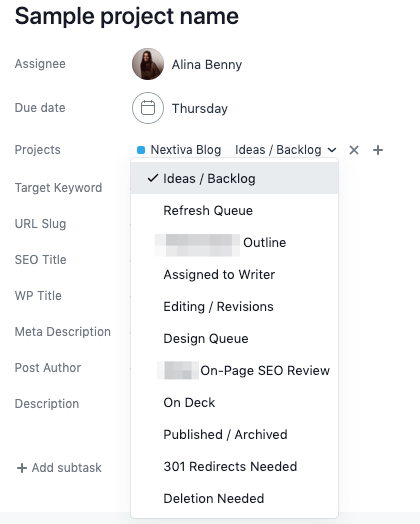May 14, 2020
 by Alina Benny / May 14, 2020
by Alina Benny / May 14, 2020

There are an abundance of talented freelancers looking for their next gigs.
If you play it right, these new independent contractors could rescue you from that steep drop-off in search traffic. But does your team know how to manage freelancers? You can’t engage with freelancers the same way you manage your in-house content team.
Unlike full-time employees, freelance writers get to choose their clients and projects. They may be working in different time zones or even different countries, and they may have minimal face-to-face contact with your team.
Many companies work with freelance copywriters and agencies every day. Here are nine rules you should swear by to produce high-quality content while working as a cohesive unit with your freelancers.
Scoring high-quality content starts with building high-quality relationships with your freelancers. That’s where we’ll begin today!
You can find thousands of freelancers all over the world on sites like Upwork. But that doesn’t mean you should churn your way through stacks of them. Freelance workers are not all created equal. Some will be a better fit for your team than others. And when you find those gems, you should build strong relationships to hang on to them.
To do this, make sure your freelance workforce feels like they’re part of your team. Try to use “us” and “we” in conversation to make sure they feel included. And don’t forget to dole out praise and recognition for jobs well done.
You should also give your freelancers everything they need to succeed, just like your in-house employees. Invite them to virtual meetings, add them to your internal email lists, etc.
Freelancing can be lonely and isolating. So efforts to get to know your remote team on a personal level go a long way. Celebrate birthdays or discuss weekend plans on your water-cooler Slack channel, for example. You’ll boost engagement and team camaraderie simultaneously.
Churning through subpar or inexperienced freelancers wastes time, money, and company resources. You’ll need to find, onboard, and test out each new writer. Then they’ll need to become familiar with your brand’s content goals and tone. This trial period could last anywhere from a few weeks to a few projects.
“The average U.S. employer spends $4,000 and 24 days to hire a new worker.”
Sapling
That’s why building relationships with freelancers is investing in your company’s future. When you find freelancers who deliver what you ask, they’ll be worth their weight in gold. Plus, giving them steady, repeat work may mean they’ll take on fewer clients and dedicate more time to your brand.
It's best to pay your freelance writers on a per-project basis instead of pay-per-word. Pay-per-word is probably the worst thing you could do. While most writers have high standards, others looking for a quick payday may not. Rather than focusing on the right metrics, they'll only concentrate on reaching the minimum target.
So you'll receive pieces full of padding and filler instead of tight, actionable copy. Then you'll need to spend extra time trimming the fat. However, your writer will still receive payment for all the words you ultimately cut during revisions.
Paying per project helps you avoid overpaying for mediocre, keyword-stuffed writing. It also puts budgetary control in your hands. Without the uncertainty of whether a piece will be 1,000 or 2,000 words, you can better plan your marketing budget. You may also earn a higher ROI for pieces that perform better.
So consider keeping your best talent on a monthly retainer if you can. Negotiating consistent, longer-term contracts may earn you a discounted rate, too.
How do your freelance writers fit into your current content strategy? What are you hoping to achieve with their help? If you’re only giving your freelancers a tone and voice guide for your brand, you’re not doing enough.
Take your freelancers through your entire content strategy and focus on elements they’re going to be helping you with specifically (i.e., long-form content, guest posts, landing pages, etc.). Explain why/how their work connects to your company’s big picture goals.
You can share internal team documents with freelancers using cloud-based technology. They’ll gain access to the same spreadsheets, charts, product images, etc. your in-house team uses. And they’ll have a complete overview of your content strategy despite working remotely.
Then continue to keep them in the loop as you reach and create new goals.
Freelancers aren’t in-house to pick up the general vibe of where your company is and where it wants to be in the future. Sharing this vision and giving them a peek at what you’re all working on in-house will help fill in the blanks. Plus, your content will appear more cohesive as a result.
Sharing your content strategy helps your writers understand and work towards your overarching goals. But project outlines decide the fate of each piece of content. Your project briefs should provide direction to reign in your freelancers' creativity. With your framework, they'll expand on your outlined ideas and create magic.
That's why every content brief should include details in context, such as:
Send over a detailed project brief before assigning any projects to your writers. Leave nothing open-ended or up for interpretation.
Well-rounded project briefs tell your writers precisely what you want and what you're expecting of them. They ensure fewer surprises and cut down editing rounds. Project managers can also use these outlines as a quality review checklist. They'll see how well your writers followed directions and achieved the objectives you set.
There are many key performance indicators (KPIs) to track and measure the success of your content strategy. Therefore, along with your project briefs, it’s also essential to give your writers a priority list of metrics you’re monitoring.
Should they be focusing on driving traffic and generating organic leads? Should they try to convert, upsell, and improve retention? Or are you simply trying to rank #1 in a particular search term? All of these metrics matter to a writer.
If they’re focusing on shares and impressions, but your KPIs are tied to backlinks from 50+ DA websites, reporting is going to be messy. And you’ll have a much harder time gauging the impact of your efforts. Always include the specific metrics you want your writers to think about when they’re crafting each piece.
Understanding the measurable goals of a project will help your writers craft content to meet those objectives. If your KPIs improve, you’ll know what’s working and can replicate it. KPIs that don’t budge will show you what needs tweaking and adjusting. Either way, you’ll have a system to gauge everyone’s work performance.
You should have one person directly responsible for how your content freelancers perform. This point of contact, known as an SEO gatekeeper, will behave like a project manager in a sense.
They'll be in charge of your task management platform and assign work to your freelancers. As your freelancers submit their work, the gatekeeper makes sure each piece hits the mark. So they must also know the ins and outs of your content strategy goals and KPIs.

Your gatekeeper will provide real-time updates and push out content on a consistent, steady schedule. If they sense a bottleneck from a single freelancer, an agency, or your team, they'll work to clear it up.
Many teams track all content projects via project boards, as seen above. This way, there are clear steps for every stage of the content production process tied to a deadline. Gatekeepers may even have a role in hiring freelancers since they know what to look for in high-quality content producers.
Your SEO gatekeeper is the go-between your freelance team and in-house employees. They'll keep everything organized and on-schedule for maximum cohesion. Your freelancers will also know who to reach out to when issues come up.
Onboarding new freelancers gives them a rundown of what to expect from your work relationship. This process helps them understand the nuts and bolts of your business and how they should behave.
“Onboarding programs have been shown to increase retention by 25% and improve employee performance by up to 11%.”
Clear Company
You may want to draft an eBook or document with your company policies to send out. Or consider creating an onboarding video to pass along to all new team members.
Either way, you’ll want to outline your:
Be as clear as possible here. Walk your freelancers through how you want them to handle each project from start to finish. Let your freelancers know what must be done and what they have more flexibility with.
While idiosyncrasies from one or two freelancers may be ok to deal with, you don’t want everyone on your team to do things their way.
Outlining your company expectations streamlines and speeds up the content process. Everyone will use the same tool to stay in touch, for example. And the content will all look and sound as if it came from the same brand voice, not a dozen different writers.
Freelancers don't need babysitting. They're a disciplined bunch with excellent time management skills. Most crave autonomy and despise someone barking orders over their shoulder. So once you send out your expectations for content, you’ll need to trust your freelancers to come up with an A+ first draft on time.
You may be tempted to have your freelancers clock in using online time-tracking tools. But these digital timesheets aren’t worth the hassle. Time spent working doesn’t always translate to successful content.
Instead, use your project management tools to see where your freelancers are on their deliverables and establish a check-in procedure everyone can agree on. Making 10 team phone calls every day isn’t ideal. But quick status updates on Slack are totally manageable. These check-ins make sure everything’s on track before you start missing deadlines.
Micromanaging tells freelancers that you don’t trust them to complete their work correctly or on time. Remember, you’re not your freelancer’s only client. You cannot check in a million times a day when they may be working on projects for other companies. And constant check-ins may be impossible to juggle for writers in different time zones.
Micromanaging is the quickest way to lose your talented freelancers. So as long as they stick to your submission rules, give them all the space they need.
No one likes 10 rounds of back-and-forths! Just like you create an outline before your freelancers begin their draft, give them instructions on what revision requests they can expect too.
To create a feedback process, consider:
These will help you track both how individual freelancers and the team are performing. Also, think about how you can improve this process for every freelancer or agency.
Suppose you notice one writer always uses British English instead of American English. Make this an instruction in your outline. Or another agency consistently produces copy with excessive passive voice. Add notes on how they should focus on readability before they submit a draft.
You don’t have to give freelancers yearly formal reviews. But constructive feedback lets them know whether they’re exceeding or falling short of your expectations.
Freelancers thrive on praise since they very rarely get that working solo. But if they don’t take your advice to shape up, you may want to cut ties. You don’t have to go through a performance review or worry about severance pay since they’re not one of your employees.
This feedback process should also go both ways. Ask your freelancers how your internal team can improve operations as well. Ultimately, this feedback should improve everyone’s output.
What's the secret to learning how to manage freelancers? Building solid relationships. When your freelancers feel like valued members of your team, they'll go the extra mile to produce high-quality content. This means you'll need to share your brand's content strategy, KPIs, and expectations early on.
Always resist the urge to micromanage. Instead, take advantage of project management and communication tools for updates. It keeps everyone on your team working as one cohesive unit, despite being zip codes or time zones apart. Follow these best practices, and you'll soon have a freelance team of busy bees buzzing with productivity!
As the SEO & Content Lead at Nextiva, Alina combines her expert skills in content strategy, SEO, conversion optimization, and copywriting to drive more high-intent organic traffic. Top brands she has worked with include Sales Hacker, Outreach.io, and Freshworks.
There are plenty of reasons to become a freelancer.
 by Tricia Dempsey
by Tricia Dempsey
When you read the word “gig,” another word probably comes to mind: "temporary."
 by Tricia Dempsey
by Tricia Dempsey
Freelancers aren’t the only ones thriving in the gig economy.
 by Tricia Dempsey
by Tricia Dempsey
There are plenty of reasons to become a freelancer.
 by Tricia Dempsey
by Tricia Dempsey
When you read the word “gig,” another word probably comes to mind: "temporary."
 by Tricia Dempsey
by Tricia Dempsey


